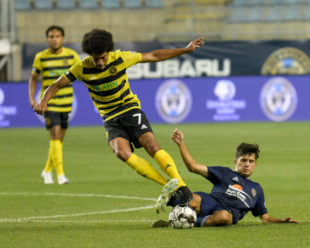Photo: Marjorie Elzey
In soccer, one usually measures success as a winning record, a stint in the playoffs, or at the very least, a positive goal differential. You know, traditional measures of success in the sport. But that’s not how the Union II should define success this season, mostly because the Union II isn’t the most traditional of soccer clubs.
Pandemic aside, the Union II struggled this season. Winning record? No, they went 2-3-11 in 16 matches. A stint in the playoffs? No, they finished 4th in Group F and 33rd out of all 35 clubs, didn’t qualify for the playoffs this year. A positive goal differential then? Also no, it was -25, the second worst in the league. In other words, the Union II did not have a successful season on paper.
But that’s not how we should grade the Union II. Remember, this is a development team, a step in the organization’s professional career making path. At times it’s hard to remember life before the pandemic, but the past few years for the Bethlehem Steel (because this is still the first year under the club’s rebrand to Union II) were decent seasons in the USL.
From 2016 through 2018, the Steel was more like a separate club, still affiliated with the Union, but not acting really acting like a farm team. They made the playoffs in 2017 and 2018, finishing higher each year. The shift in the club’s purpose became obvious in 2019. That year, the team’s average age was at its youngest than previous years, and homegrown signings had become more talked about as Brenden Aaronson and Anthony Fontana made their first team debuts. Plus, Ernst Tanner had come in for his first real year as Sporting Director and told then head coach, Brendan Burke that his club’s purpose was all about developing youth talent for the first team.
Youth development is how the Union II should be measuring success this season. So, how successful were they in 2020?
There are three names that stand out for the Union II this season, three young players who have signed homegrown first team contracts: Nathan Harriel, Jack McGlynn and Paxten Aaronson.
Pretty successful, signing a 19-year old defender, a 17-year old midfielder and a 16-year old midfielder respectively, if you ask me. They are on pre-contracts now, and can make their Union debuts in 2021.
Then you have other key names that are coming up the pipeline. Young players like Caden Stafford, Brandan Craig, Anthony Sorenson and Jack Jasinski all saw their first professional minutes this season with the Union II, playing in at least half of the season’s matches. Stafford, Sorenson and Jasinski are all 17, born in 2003, while Craig is the youngest of those four at 16, born in 2004. This season, Stafford had 2 goals and 2 assists, Craig had a goal, Sorenson had a goal and an assist, and Jasinski had a goal.
More young talent that is being developed by the organization, more success for the club this season.
At least half of the club we saw this season were academy players, teenagers competing against professional adult athletes. That’s not likely to change any time soon. The Philadelphia Union as an organization is pretty much the best club in the league when it comes to developing youth talent, especially from its local surrounding area. Kids come from all over the country to play for the Union’s academy teams, and its because of this model that the Union II is just one part of. So when you’re looking at the records or standings and thinking about how poorly the Union II did this season, remember that that is not how the organization is measuring this club’s success.


Comments